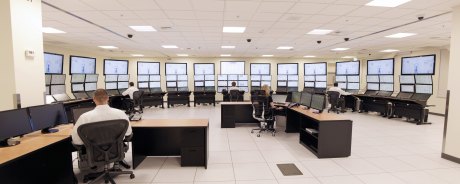Companies competing for US federal funds to support the development of operational small modular reactors (SMRs) have been keen to report progress in their respective projects, including a first control room simulator and the launch of a fuel technology centre.
NuScale Power is claiming a world first with the commissioning of a control room simulator to model the operation of its SMR design. The full-scale simulator boasts 12 independent work stations, each of which simulates the operation of one SMR module and an associated turbine generator: 12 modules would make up a standard 540 MWe power plant. The new simulator scales up a test facility that has been in operation at Oregon State University since 2003.
 |
NuScale submitted a proposal to the US Department of Energy (DoE) earlier this year seeking federal funds to match up to $226 million in costs associated with engineering, design certification and licensing for the plant. The DoE has already agreed a public-private partnership with NuScale to build a demonstration unit at the Savannah River site in South Carolina.
CEO Paul Lorenzini said the company had "changed the game in commercial nuclear power" with the plant's inherently safe design and "dramatically" lowered business risk compared to building and operating conventional nuclear power plants.
B&W fuels development
Meanwhile, Babcock & Wilcox (B&W) has formally launched a new fuel technology centre to develop the fuel fabrication capabilities for its mPower SMR. The facility, in Lynchburg, Virginia, will develop and demonstrate key fabrication technologies and processes for reactor fuel and related components, fabricate representative fuel assembly prototypes and components to support the fuel design, testing and licensing process, and serve as the materials test facility to evaluate the mechanical performance of fuel assemblies and components. The facility will not use any nuclear material.
Virginia state governor Bob O'Donnell applauded the opening of the new facility, the third major development related to the mPower program following a dedicated design office set up in 2010 and an integrated system test facility in 2011.
Like NuScale, B&W has applied for DOE funding to support the development of its reactor. B&W subsidiary Generation mPower recently signed a memorandum of understanding with FirstEnergy on studies on the potential deployment of the SMR in First Energy's service territory, which stretches across the USA's Midwest and Mid-Atlantic regions. The move was publicly welcomed by Ohio senators Sherrod Brown and Rob Portman, with Portman noting the benefits that "one or more" SMRs would bring to the state both in terms of supplying "safe, reliable, and cost-effective" energy and in supporting advanced energy careers.
O'Donnell, Brown and Portman are not the only politicians keen to add their support to SMR projects. Earlier this year Missouri governor Jay Nixon lent his support to the bid by Westinghouse to develop and manufacture its SMR in the state. Westinghouse and the Missouri Electric Alliance have signed up a group of twelve utilities and power suppliers including Exelon, Dominion Virginia and FirstEnergy to join the NexStart SMR Alliance to help secure DOE investment funds for its reactor.
The fourth major runner in the race for the DoE funding is Holtec's SMR-160. DOE has also agreed to host the first-of-a-kind reactor at Savannah River, and the company has announced that it is ready to launch the detailed design phase for the reactor.
Researched and written
by World Nuclear News




_18570.jpg)
_16159.jpg)
_18938.jpg)
_33584.jpg)





